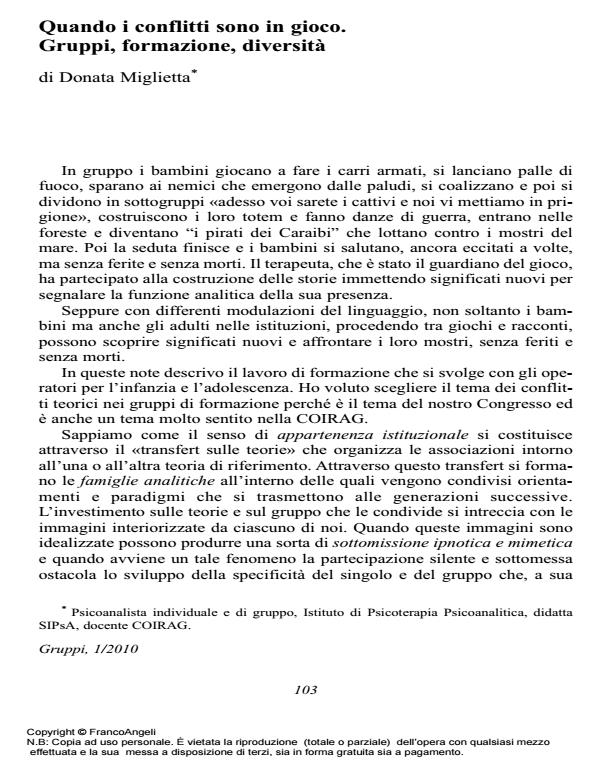When conflicts are at stake. Groups, training, diversity
Journal title GRUPPI
Author/s Donata Miglietta
Publishing Year 2010 Issue 2010/1
Language Italian Pages 8 P. 103-110 File size 289 KB
DOI 10.3280/GRU2010-001009
DOI is like a bar code for intellectual property: to have more infomation
click here
Below, you can see the article first page
If you want to buy this article in PDF format, you can do it, following the instructions to buy download credits

FrancoAngeli is member of Publishers International Linking Association, Inc (PILA), a not-for-profit association which run the CrossRef service enabling links to and from online scholarly content.
The transition from listening to body involvement which a therapist goes through in leading children’s groups has often been considered heretic both with respect to psychoanalysis and to theories concerning analytical groups. In training, we must never lose sight of the fact that - even within a single school - unified practice is an illusion (Schaffer,). The trainer’s vocation is to create a boundary that regulates the flow of disagreement and difference, ensuring that diversity does not turn into war. When differences come into focus it is necessary to deal with its effects. In child psychotherapist training groups the conflict often assumes seen and unseen images. In psychodrama training processes, paths are highlighted that evoke images ranging from clashes between armed gangs to quarrelling games, up to the integration of differences. Nowadays, psychotherapies are a galaxy with uncertain boundaries and, as trainers, we have to think of an open system of knowledge. We should be constantly aware that it is not unlikely that a process can vary from one analyst to another, and perhaps from one patient to another, in a very significant manner (Meltzer). The question is visible in the training processes of the COIRAG school, where sub-clinical groups arrive with their complex theoretical clinical matrices which are certainly not all the same. Training should move in the spirit of COIRAG, aiming to build a common story in a time when we all need peace. It is therefore important to take steps in this process through training for child group leaders. The path leading through the surfacing of theoretical differences, clashes, and confrontation in training for child group leaders is described. By analogy to children’s games, the leaders, too, modulate the intensity of the conflict through the appearance and movement of game images. Conflict that becomes a game can foster a comparison between theoretical and technical differences.
Keywords: Ideologies, transformations in games, training, children’s groups, play, leaders.
Donata Miglietta, Quando i conflitti sono in gioco. Gruppi, formazione, diversità in "GRUPPI" 1/2010, pp 103-110, DOI: 10.3280/GRU2010-001009